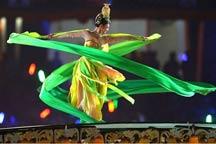On this episode of Travelogue, the Li Minority of the subtropical paradise of Hainan let the craft ness of their hands and the beauty of their song and dance sweep us away.
Variety of China’s landscape, diversity of its people, welcome to Travelogue, ethnic series. We’re in Hainan. We welcome you to visit us and the great, people and show you their music and dance.
The Li Minority resides in a subtropical paradise, the Li-Miao Autonomous Prefecture in Hainan. With a population of 1.3 million, the ethnic group consists of five branches, which speak different dialects, wear different costumes, and have other regional differences. However, their common ancestors can be traced back to a branch of the ancient Baiyue tribe, who once lived in southern China. These people immigrated to Hainan over 3,000 years ago, making them the earliest settlers of Hainan.
Inspired by the natural environment, their creations, the boat-shaped cottages, and superb song and dance, are world-known. Their architecture and art forms liven up the atmosphere and bring you into their unique world.
We are here just in time for the March Third Festival, which is the most famous Li celebration. Originally, the festival’s purpose was to ask for blessing for the harvest of crops.
The legend is that in ancient times, a major flood brought death to many Li people living by the Changhua River in Hainan. Only two lovers survived, who were washed away to Mount Yanwo. On March 3rd of the lunar calendar, the waters receded and they married. Here, they made textiles, raised children, planted crops and fished, and became the first Li peoples. To commemorate them, Li people gather by the Changhua River every March 3rd to sing and remember.
Gradually this gathering evolved into a traditional Festival during which young people of the Li villages interact and search for suitable lovers.
People make preparations for the festival weeks in advance. Women start cooking and young men hunt in the forest. They will get back to the village on the festival, talk about their experience and show off their bravery to try to get girls' favor. During the festival of love, people organize song and dance parties. In the evening, young men and girls sit around the campfires by the waters, on the tops of mountains, to sing and dance together. The girls are dressed in fine jewelry and multicolored clothing, and the men wear red bands on their waists. On this big dating scene, the girls and boys express their emotions in song. The sweet love songs start out gentle and lyrical to being bold and unreserved. If both parties feel like it’s a good match, they exchange small totems to make arrangements for the next date. During this holiday, songs, dances, archery, and many recreational activities surround Li people, and festivity fills the air. Today, March Third festival has become, in some sense, a huge pageant of Li minority life. For the young men and women, it’s a chance to find that special someone, for the elders, it’s a time to get busy cooking, doll up their daughters, and have some fun with the community. For tourists, it’s a chance to see Li life in its purest form.
Well, early mornings like this, I hate myself sometimes. I need to get up early, because behind me there is this beautiful mountain called the “five fingers mountain”. This is because it’s shaped in five fingers, which is famous in Hainan. And here is the hotel, they like a morning tea. And if I can get up early I can see the sunrise and it’s trail right behind me. I can take the trail and climb the top of the mountain and enjoy the best view, such as the sunrise.
Many Li people live in the area surrounding the famous Five Finger Mountain in central Hainan, the highest mountain in the province. The mountain gets its name from its waving peaks that appear like the five fingers. The mountains are representative of Hainan and there are many legends surrounding its existence. One legend has it that the five peaks are the fossilized fingers of a dead Li clan chief. Another tale is that the five peaks are dedicated to the five most powerful Li gods. Because of the mild climate in Hainan, the mountain is rich in vegetation and wildlife. If you chose to climb the mountain, you’ll surely notice the misty mountaintops, layer upon layer of lush greenery, and diversity of animal species. It is the archetypical Chinese beautiful mountain. The scenery here is spectacular and so it’s no wonder that dozens of painters, poets, and artists have visited the mountain for creative inspiration.
Next we head to Chubao Li village, the most completely preserved Li village, where we can see local farming life. It is located in the city of Wuzhishan, Maoyang County, to the west of “five finger mountain”.
Here, local Li people go about their traditional ways of life, living in houses that look like overturned boats. The Li nationality lives mainly on agriculture. Hainan is in a subtropical zone, with fertile lands and abundant rainfall, very suitable for agriculture. The area is the country's major producer of tropical crops like coconut, pineapples, cocoa, coffee, palm oil, cashews, mangoes and bananas. Besides agriculture, other industries such as hunting, handicrafts, fishing, commerce and forestry also play an important role in their economy.
It’s not easy to find a original village, where you still have people using their traditional house and materials. We’ve found it right here. This is the entrance of this village. This little village only has 84 families. Actually, I’ve been told, you can’t count those little houses behind me. These houses are not for them to live in, but for them to stock their food. For their rice for example. So every family has their own house where they can stock their food for a whole year.
So by counting those little houses, you can see how many families live here. And I’m going to go in and find out. Actually, these houses are their really houses. There is a little entrance to go in.
Now, we’re officially getting into the village and now we’re going to find out how they live. This is very natural ethnic group, they’ve been living here for many years and they still keep it the traditional way.
Everything is from material. Let me tell you something about the structure of this house. Everybody is leaving a structure like this, we can see. I was told that all the material is brought from the mountain to here. Here we have bamboo, of course. And then you have a lot of straws on the sealing, which protects from the rain and wind. And then you have some sort of wood; it’s like a tree branch. In between they’ve this really thin ban of bamboo, to wrap it around and to hold the total construction. No nails no other materials, but wood, bamboo and straws. All materials from the mountains brought to here.
For some people, living in boats all year round is common. However, these boats aren’t your typical boats, because rather than in the water, they remain on land. The roofs of these houses are supported with tree trunks and the walls are made of knotted bamboo strips coated with mud. The unique houses of the Li are designed to withstand the storms that hit the tropical island.
Take a guess, what’s this in my hand? It’s a bag.
It’s very popular for local ladies. Everyone has one.
It’s made out of bamboo. It’s very tight and strong. They have two strings coming out and what you do is tight those two string around your waste, like this. So you can put everything in here. It’s very popular here. If you don’t understand, let me tell you this. Like for example, in the big cities, like metropolitan cities. Everybody is carrying a Chanel or LV bag. THIS is a local village Chanel and LV, cause everyone needs to have one of these.
In this small village, there are 61 households and 330 people. Traditionally, Li people lived a communal life with men taking care of hunting while women do all the household work.
The Yi people live in harmony with nature. Living alongside the mountains, they use the resources that Mother Nature has blessed them with to satisfy all their needs in daily life. They also build pole-supported houses out of practicality, since these raised homes rest above the waters. From a birds eye view, the entire village appears untouched by modernity. As China’s only ancient preserved Li village, Chubao is where Li’s traditional lifestyle and culture have remained.
Li brocade is the earliest type of clothing product in China, according to historical records, dating back as far back as 2,500 years ago. Woven of cotton yarn and silk thread, Li brocade is mainly used to make women's tube-shaped skirts and bags, as well as other clothing products with vivid colors. It usually includes spinning and weaving to dying and embroidering. In Hainan, no matter which village you are in, you can find Li women busying themselves making dresses, blouses, hats, wraps, and bags, and multicolored images.
The textile tools of the Li and simple and ancient, but the products produced are internationally acclaimed, intricate and exquisite. Ancient historical records mention the importance Li brocade had on the development of textile making in China.
According to historical records, in the Han dynasty over 2,000 years ago, the Li people were dressed in cloth made from wild flax. Processed wild flax was known as “Li cloth. In the Tang dynasty, around the 7th century, Li spinning and weaving techniques were way ahead of the rest of China. Li women used the same technique to make blankets, tablecloths and other items to offer to the imperial palace. A female scientist named Huang Daopo of the Yuan Dynasty went to Hainan to study the techniques of the
 2009 China Central Television. All Rights Reserved
2009 China Central Television. All Rights Reserved

















